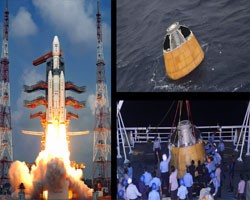SSC Current Affairs
| Science and Technology |
|---|
|
|
|
Why in the news?
India’s space exploration program reached a pivotal milestone as Isro commences the assembly of the Human-Rated Launch Vehicle Mark-3 (HLVM3) at the Satish Dhawan Space Centre (SDSC), marking the start of the Gaganyaan-G1 launch campaign. Key Takeaways: The mission, scheduled for 2025, will be the first uncrewed flight under the ambitious Gaganyaan human spaceflight program. The event coincides with the 10th anniversary of the LVM3-X/CARE mission, conducted on December 18, 2014. The 2014 mission demonstrated critical technologies for human spaceflight, including the successful launch and recovery of a Crew Module. During that mission, the LVM3-X lifted a 3,775 kg Crew Module to a suborbital altitude of 126 km, followed by a controlled re-entry and splashdown in the Bay of Bengal. These achievements laid the groundwork for the Gaganyaan program, officially approved in 2019. The HLVM3, an evolution of the LVM3, has been specifically designed for human spaceflight with enhanced reliability and safety systems. It is a three-stage vehicle standing 53 meters tall, weighing 640 tonnes, and capable of carrying 10 tonnes to low Earth orbit (LEO). Key upgrades include a human-rated design and the integration of a Crew Escape System (CES), which can safely eject the Crew Module in the event of an anomaly during ascent. LVM3 ASSEMBLY BEGINS: Isro began stacking the nozzle-end segment of the S200 solid rocket motor on Wednesday, officially launching the HLVM3-G1 campaign. The S200 motors are undergoing assembly, while the L110 liquid stage and C32 cryogenic stage are ready for integration at the launch complex. Meanwhile, the Crew Module is being integrated at the Vikram Sarabhai Space Centre (VSSC), and the Service Module at the U.R. Rao Satellite Centre (URSC). The Orbital Module’s final integration and testing will follow at URSC, Bengaluru. The HLVM3-G1 mission is critical for testing the human-rated systems in an uncrewed environment. The Crew Module features advanced safety margins, multiple redundancies, and re-entry technologies validated through the LVM3-X/CARE mission. This data will be instrumental in ensuring the success of future manned missions. Isro’s legacy in developing heavy-lift launch vehicles has been pivotal for India’s space ambitions. The insights from earlier missions have guided the design of the Gaganyaan spacecraft, with lessons from pad abort tests, air-drop experiments, and system evaluations ensuring readiness for human spaceflight. The maiden Gaganyaan flight will also contribute to India’s long-term vision of building the Bharatiya Antariksh Station (BAS). About Gaganyaan Mission: Gaganyaan is a mission by the Indian Space Research Organisation (ISRO). Under the Gaganyaan schedule: Three flights will be sent into orbit. There will be two unmanned flights and one human spaceflight. The Gaganyaan system module, called the Orbital Module will have three Indian astronauts, including a woman. It will circle Earth at a low-earth-orbit at an altitude of 300-400 km from earth for 5-7 days. Payloads: The payload will consist of: Crew module - spacecraft carrying human beings. Service module - powered by two liquid propellant engines. It will be equipped with emergency escape and emergency mission abort. Launch: GSLV Mk III, also called the LVM-3 (Launch Vehicle Mark-3,) the three-stage heavy lift launch vehicle, will be used to launch Gaganyaan as it has the necessary payload capability. Training in Russia: In June 2019, the Human Space Flight Centre of the ISRO and the Russian government-owned Glavkosmos signed a contract for the training, which includes Russian support in the selection of candidates, their medical examination, and space training. The candidates will study in detail the systems of the Soyuz manned spaceship, as well as be trained in short-term weightlessness mode aboard the Il-76MDK aircraft. The Soyuz is a Russian spacecraft. The Soyuz carries people and supplies to and from the space station. The Il-76MDK is a military transport plane specially designed for parabolic flights of trainee astronauts and space tourists. Significance: It will help in enhancement of science and technology levels in the country and help inspire youth. Gaganyaan will involve numerous agencies, laboratories, disciplines, industries and departments. It will help in improvement of industrial growth. Recently, the Government has announced a new organisation, IN-SPACe, part of reforms to increase private participation in the space sector. It will help in development of technology for social benefits. It will help in improving international collaboration. One International Space Station (ISS) put up by multiple countries may not be enough. Regional ecosystems will be needed and Gaganyaan will focus on regional needs: food, water and energy security. IN SHORT: The HLVM3 is an evolution of the LVM3 rocket It has been specifically designed for human spaceflight It is a three-stage vehicle standing 53 meters tall |
| >> More SSC Current Affairs |
